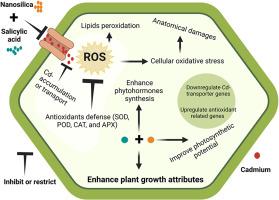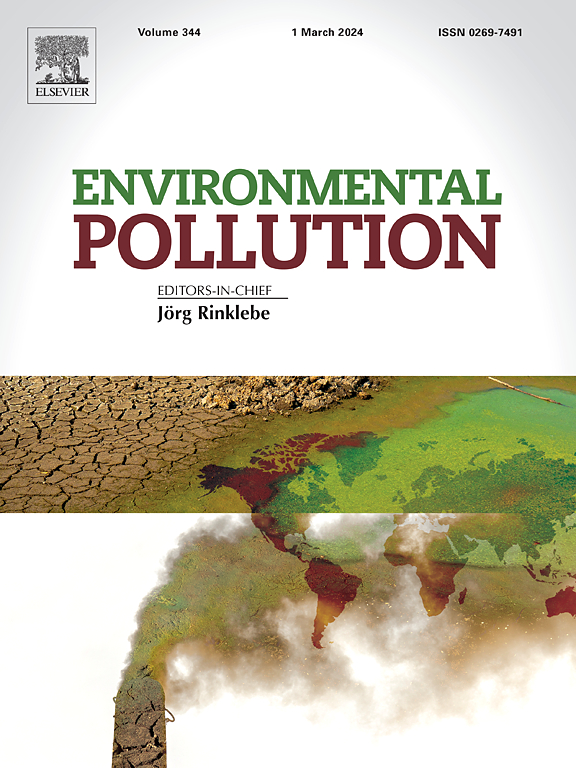Nanosilica and salicylic acid synergistically regulate cadmium toxicity in rice
IF 7.3
2区 环境科学与生态学
Q1 ENVIRONMENTAL SCIENCES
引用次数: 0
Abstract
Cadmium (Cd) toxicity negatively impacts plant health and productivity. Nanosilica (SiO2NPs) and salicylic acid (SA) enhance plant performance and alleviate heavy metals stress. Yet, their combined effects against Cd-toxicity in rice remained less-explored. Thus, a hydroponic study investigated the individual and combined effects of SiO2NPs and SA on Cd-stress mitigation in rice at physio-biochemical, cellular, and molecular levels. Results indicated that Cd-alone treatment caused a significant reduction in rice growth and biomass and photosynthetic efficiency, which was associated with oxidative damage caused by enhanced Cd-accumulation in plant tissues. Cd-induction also potentiated its phytotoxicity by triggering enzymatic antioxidants against the extra production of reactive oxygen species (ROS). The addition of SiO2NPs and/or SA markedly minimized the Cd-induced toxicity by reducing Cd-bioaccumulation (42–56%), protecting photosynthetic efficiency, which were directly correlated with seedling biomass and restored cellular structures (leaf ultrastructure and surface morphology). The combined application of SiO2NPs and SA was more effective in activating antioxidant enzymes, phytohormones biosynthesis, and reducing oxidative damages caused by Cd than sole application. This was evident in the decreased production of ROS, malondialdehyde contents (29–37%), and recovered membrane stability. Moreover, SiO2NPs and/or SA relieved Cd-bioaccumulation (41–56%) by downregulating the Cd-related transporter genes (OsNramp1, OsNramp5, OsHMA2, and OsHMA3). Altogether, the cellular Cd-accumulation, photosynthesis, antioxidant defense, and phytohormones against oxidative stress can be ideal markers for cultivating rice in Cd-contaminated soils.


纳米二氧化硅和水杨酸协同调节水稻中的镉毒性
镉(Cd)毒性对植物的健康和生产力产生了负面影响。纳米二氧化硅(SiO2NPs)和水杨酸(SA)可提高植物的生长性能,缓解重金属胁迫。然而,这两种物质对水稻镉毒性的综合效应仍未得到充分探索。因此,一项水培研究从生理生化、细胞和分子水平研究了 SiO2NPs 和 SA 对缓解水稻镉胁迫的单独和联合作用。结果表明,单用镉处理会导致水稻生长、生物量和光合效率显著降低,这与植物组织中镉积累增加导致氧化损伤有关。镉诱导还通过触发酶抗氧化剂来对抗活性氧(ROS)的额外产生,从而增强其植物毒性。通过减少镉的生物累积(42-56%)、保护光合效率(光合效率与幼苗生物量直接相关)和恢复细胞结构(叶片超微结构和表面形态),SiO2NPs 和/或 SA 的添加明显减少了镉诱导的毒性。在激活抗氧化酶、植物激素生物合成和减少镉造成的氧化损伤方面,联合施用 SiO2NPs 和 SA 比单独施用更有效。这表现在 ROS 生成减少、丙二醛含量降低(29-37%)以及膜稳定性恢复。此外,SiO2NPs 和/或 SA 通过下调镉相关转运体基因(OsNramp1、OsNramp5、OsHMA2 和 OsHMA3),缓解了镉的生物累积(41-56%)。总之,细胞镉积累、光合作用、抗氧化防御和抗氧化胁迫的植物激素可以作为在镉污染土壤中种植水稻的理想标记。
本文章由计算机程序翻译,如有差异,请以英文原文为准。
求助全文
约1分钟内获得全文
求助全文
来源期刊

Environmental Pollution
环境科学-环境科学
CiteScore
16.00
自引率
6.70%
发文量
2082
审稿时长
2.9 months
期刊介绍:
Environmental Pollution is an international peer-reviewed journal that publishes high-quality research papers and review articles covering all aspects of environmental pollution and its impacts on ecosystems and human health.
Subject areas include, but are not limited to:
• Sources and occurrences of pollutants that are clearly defined and measured in environmental compartments, food and food-related items, and human bodies;
• Interlinks between contaminant exposure and biological, ecological, and human health effects, including those of climate change;
• Contaminants of emerging concerns (including but not limited to antibiotic resistant microorganisms or genes, microplastics/nanoplastics, electronic wastes, light, and noise) and/or their biological, ecological, or human health effects;
• Laboratory and field studies on the remediation/mitigation of environmental pollution via new techniques and with clear links to biological, ecological, or human health effects;
• Modeling of pollution processes, patterns, or trends that is of clear environmental and/or human health interest;
• New techniques that measure and examine environmental occurrences, transport, behavior, and effects of pollutants within the environment or the laboratory, provided that they can be clearly used to address problems within regional or global environmental compartments.
 求助内容:
求助内容: 应助结果提醒方式:
应助结果提醒方式:


